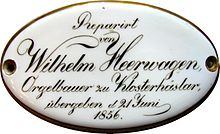Wilhelm army car
Wilhelm Heerwagen (born November 5, 1826 in Blankenburg , † September 26, 1875 in Klosterhäseler ) was a German organ builder . He founded the organ construction company Heerwagen , which existed until 1935.
Life
Friedrich Wilhelm Heerwagen, son of the carpenter Johann Friedrich Heerwagen from what is now Bad Blankenburg in Thuringia, completed his training in the workshop of Johann Friedrich Schulze in Paulinzella . On September 29, 1854, he married Karoline Henriette Keller, the daughter of the cabinet maker Paul Keller, in Klosterhäseler . In 1855 he went into business for himself and opened his first workshop in Klosterhäseler in the outbuilding of homestead No. 54. In addition to a carpenter and a pewter journeyman, he also initially employed his younger brother Carl Friedrich August Heerwagen (* December 13, 1829 - † March 29, 1882 ), who later also went into business for himself, but without economic success. His wife helped him with his work, which was extremely unusual in this craft in the 19th century. Their collaboration is proven by an inscription in the Poppe organ from 1818 in Gößnitz, now the municipality of An der Poststraße . Here he had carried out maintenance and tuning work with her.
The couple lived in a small house with number 53 near the workshop. The marriage resulted in three children, Henriette Wilhelmine Rosalie (born March 3, 1855 in Klosterhaeseler; June 25, 1913 in Gotha), Carl Friedrich Wilhelm, who died as a toddler and on December 5, 1857 son Friedrich Wilhelm Emil Heerwagen as a later heir of the business. Karoline Henriette Heerwagen died in childbed in 1859 at the age of 27. The second marriage to Friederike Ernestine Kleine, who married Heerwagen in 1860, remained childless. Like his first wife, she came from Klosterhäseler.
Heerwagen carried out new buildings, conversions and repairs with his employees. The organ in Klosterhäseler also comes from his workshop. It was donated in 1871 by August and Emilie von Haeseler as the redemption of a vow for the healthy return of their sons from the war against France.
His business went through ups and downs. There must have been an economic low point in 1874. When his workshop built the new organ for the church in Rothenberga in 1874, he also took over demolition, carpentry, bricklaying and painting work in the church building. The following year he suddenly died at the age of 48 on September 26, 1875. His son Emil was only 18 years old, so he was not even of legal age at that time. He continued to run the workshop, although a master organ builder had to assist him as a guardian during organ acceptance tests until the age of majority.
literature
- Rolf Walther: Wilhelm and Emil Heerwagen - organ builders shape a region. For the 180th birthday of Wilhelm Heerwagen. In: Ars Organi . 54, 2006, pp. 228-229
- Rudi-Arnold Jung: The organ builders Heerwagen in Klosterhäseler, Bad Kösen and Weimar . Typescript in the Klosterhäseler organ building museum .
- Parish archives Bad Bibra: church records from Klosterhäseler
Web links
| personal data | |
|---|---|
| SURNAME | Army car, Wilhelm |
| BRIEF DESCRIPTION | German organ builder |
| DATE OF BIRTH | November 5, 1826 |
| PLACE OF BIRTH | Blankenburg |
| DATE OF DEATH | September 29, 1875 |
| Place of death | Klosterhäseler |
